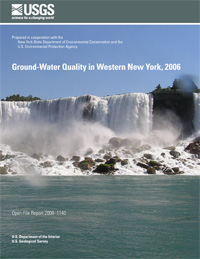Open-File Report 2008–1140

This report is available as a printed product and in PDF
Format (3.5 MB)
If you have Adobe® Acrobat® or Adobe® Acrobat® Reader® installed on your computer, you may view and print the PDF version of this report. Acrobat Reader, is a free download from Adobe Systems, Inc. Users with disabilities can view information concerning accessibility at access.Adobe.com.
Suggested citation: Eckhardt, D.A.V., Reddy, J.E., and Tamulonis, K.L., 2008, Ground-water quality in western New York, 2006: U.S. Geological Survey Open-File Report 2008–1140, 36 p., available only online at https://pubs.usgs.gov/of/2008/1140
Water samples were collected from 7 production wells and 26 private residential wells in western New York from August through December 2006 and analyzed to characterize the chemical quality of ground water. Wells at 15 of the sites were screened in sand and gravel aquifers, and 18 were finished in bedrock aquifers. The wells were selected to represent areas of greatest ground-water use and to provide a geographical sampling from the 5,340-square-mile study area. Samples were analyzed for 5 physical properties and 219 constituents that included nutrients, major inorganic ions, trace elements, radionuclides, pesticides, volatile organic compounds (VOC), phenolic compounds, organic carbon, and bacteria.
Results indicate that ground water used for drinking supply is generally of acceptable quality, although concentrations of some constituents or bacteria exceeded at least one drinking-water standard at 27 of the 33 wells. The cations that were detected in the highest concentrations were calcium, magnesium, and sodium; anions that were detected in the highest concentrations were bicarbonate, chloride, and sulfate. The predominant nutrients were nitrate and ammonia; nitrate concentrations were higher in samples from sand and gravel aquifers than in samples from bedrock. The trace elements barium, boron, copper, lithium, nickel, and strontium were detected in every sample; the trace elements with the highest concentrations were barium, boron, iron, lithium, manganese, and strontium. Eighteen pesticides, including 9 pesticide degradates, were detected in water from 14 of the 33 wells, but none of the concentrations exceeded State or Federal Maximum Contaminant Levels (MCLs). Fourteen volatile organic compounds were detected in water from 12 of the 33 wells, but none of the concentrations exceeded MCLs.
Eight chemical analytes and three types of bacteria were detected in concentrations that exceeded Federal and State drinking-water standards, which are typically identical. Sulfate concentrations exceeded the U.S. Environmental Protection Agency (USEPA) Secondary Maximum Contaminant Level (SMCL) of 250 milligrams per liter (mg/L) in three samples, and chloride concentrations exceeded the SMCL of 250 mg/L in two samples. Sodium concentrations exceeded the USEPA Drinking Water Health Advisory of 60 mg/L in nine samples. Iron concentrations exceeded the SMCL of 300 μg/L (micrograms per liter) in 14 filtered samples, and manganese exceeded the USEPA SMCL of 50 μg/L in 15 filtered samples, as well as the New York State MCL of 300 μg/L in 1 filtered sample. Arsenic exceeded the USEPA MCL of 10 μg/L in two samples, aluminum exceeded the SMCL for aluminum of 50 μg/L in one sample, and lead exceeded the MCL of 15 μg/L in one sample. Radon-222 exceeded the proposed USEPA MCL of 300 picocuries per liter in 24 samples. Any detection of coliform bacteria indicates a violation of New York State health regulations; total coliform was detected in 12 samples, and Escherichia coli was detected in 2 samples. The plate counts for heterotrophic bacteria exceeded the MCL (500 colony-forming units per milliliter) in four samples.
Director
U.S. Geological Survey
New York Water Science Center
425 Jordan Road
Troy, NY 12180
(518)285-5600
or visit our Web site at: http://ny.water.usgs.gov